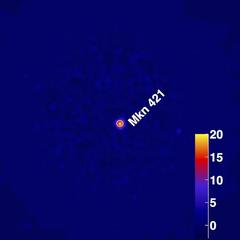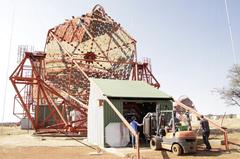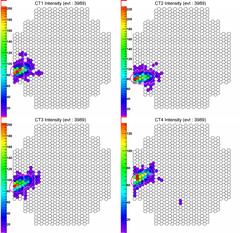URL: https://www.desy.de/news/news_search/index_eng.html
Breadcrumb Navigation
DESY News: New eyes for the gamma-ray sky
News
News from the DESY research centre
New eyes for the gamma-ray sky
The newly refurbished cameras of the H.E.S.S. gamma-ray telescopes in Namibia have detected their first signals from a cosmic particle accelerator: The new cameras recorded Markarian 421 as their first target, a well-known blazar in the constellation of Ursa Major. The active galactic nucleus, 400 million light years away, was detected during an active state and at high significance. After four years of development, testing, production and deployment, this is the last big milestone of the H.E.S.S. I camera upgrade project, which was led by DESY. The success is also an important test for the next generation gamma-ray observatory, the Cherenkov Telescope Array CTA, which will use the same camera technology.

Cosmic gamma radiation from the active galactic nucleus Markarian-421, recorded by the new H.E.S.S. cameras. Credit: H.E.S.S.
In the ten years for which the original H.E.S.S. I cameras have been operated, their fragile electronic components have suffered a natural level of ageing, which degraded their performance. In parallel, also the technologies available on the market have developed much further, like faster Ethernet solutions, and smaller and faster readout chips. One of these chips is the NECTAr chip, which has been developed for the next big experiment in the field, CTA. Therefore, in 2012 the H.E.S.S. collaboration placed an order with their new collaborators at DESY in Zeuthen to team up with colleagues from the Paris area and Universities of Leicester and Amsterdam to make use of this chip and design a new, modernised version of the four H.E.S.S. I cameras.

Installation of the new cameras in Namibia. Credit: Stefan Klepser, DESY
After the installation, software needed to be adjusted, network connections to be established, and real-life, unexpected issues needed to be trouble-shooted. Around Christmas 2016 the systems were all fit for observation, and as luck would have it, an old friend in the gamma-ray sky, the blazar Markarian 421 was reported to show increased activity. Despite being located in the Northern sky, in the constellation of Ursa Major, it was within reach for observations by H.E.S.S. The scientists turned the four telescopes at it and could record thousands of images.
"The refurbished cameras delivered the first large scale demonstration that the NECTAr technology is fit for teraelectronvolt astronomy", summarises Christian Stegmann, head of the DESY institute in Zeuthen. "This makes us look forward to the final years of H.E.S.S., where the new cameras will provide us with enhanced performance at both very low and very high energies. And it is a promising outlook at the next major gamma-ray observatory CTA, where DESY is an important partner."




